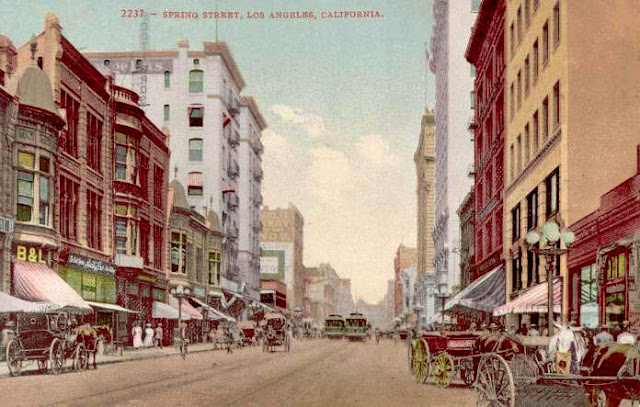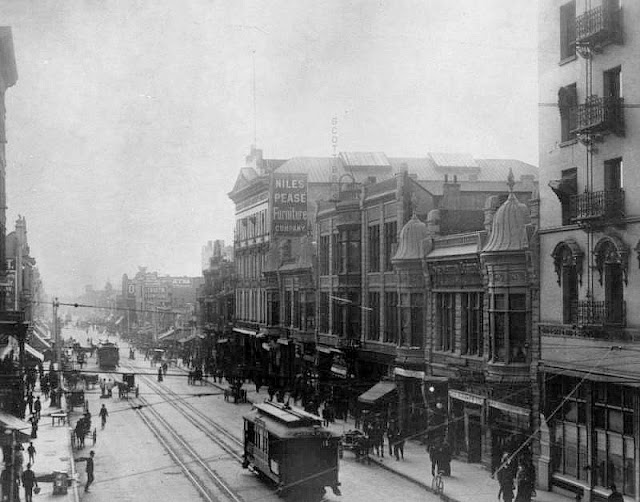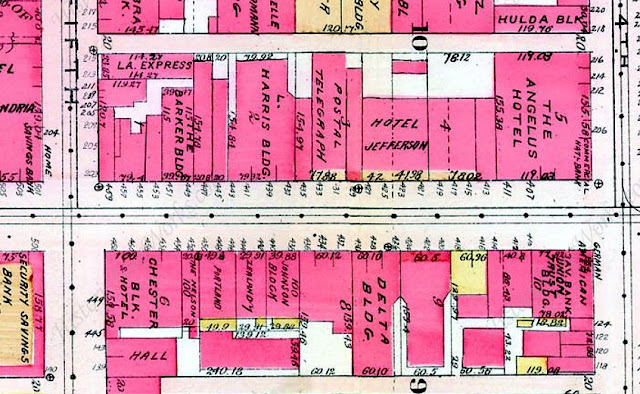423 S. Spring St. Los Angeles, CA 90013 | map |
Opened: April 1908 as Fischer's Chronophone under the management of local theatre operator E. A. Fischer. It was also referred to as the Chronophone Theatre.
The building the Chronophone would move into is seen as the very pink one on the left of this c.1905 postcard. The theatre, at 423, was just beyond the building's center bay. Thanks to Brent Dickerson for sharing it in the "Spring St. Part 2" chapter of his epic series "A Visit to Old Los Angeles." We're looking north toward the Angelus Hotel on the southwest corner of 4th and Spring, a building that opened in 1901.
Seating: 350
The theatre initially specialized in shorts demonstrating an early talkie process
from the Gaumont studios, the Gaumont Chronophone. The system used
records synched to the projector, much like the years later Vitaphone
process. The speakers were set up beside the screen and the sound was
amplified pneumatically by a compressed air system, rather
than electronically.
The book "Early Cinema and the 'National'" by Richard Abel mentions the Chronophone Theatre on page 44 and notes that when it opened it was doing capacity business for both matinee and evening performances. It's on Google Books. The April 26, 1908 Los Angeles Herald reported on page 24 that every seat was sold for the theatre's opening week.
The June 14, 1908 Los Angeles Herald discusses Mr. Fischer's problem with records and films that were quickly deteriorating. By then he had signed a contract directly with Gaumont (who had their U.S. studio in Flushing, N.Y.) so he could get "fresher" product instead of dealing with a Los Angeles distributor. The July 5, 1908 Los Angeles Herald had an item on the Chronophone's "Grand Opera Week" that featured imported sound films highlighting great opera performances. The Flushing operation was also producing English language titles both operatic and otherwise. The Herald issues can be seen on the site of the California Digital Newspaper Collection.
Fischer also ran the nearby 1st St. legit/vaudeville venue known as Fischer's Theatre (later renamed the Princess) and was for a time operating the Lyceum Theatre as well. He also operated Fischer's Theatre in Pasadena (later renamed the Oaks) and had theatres in San Francisco as well, including the pre-quake Fischer's Theatre on O'Farrell St.
In late 1908 the theatre was taken over by Robert A. Brackett, who was also exhibiting sound films at the Royal Theatre on Broadway. The Royal was also running Gaumont films and using their equipment. Brackett was a "reformer" who was interested in doing higher-class presentations (without all the chases and violence) that were seen in most nickelodeons at the time. Starting in November 1908 the Los Angeles Herald got on the film reform bandwagon and offered free coupons to Brackett's shows. Not to be outdone by the competition, Hearst's Examiner and other papers started to print coupons for various nickelodeons running the normal, more sensational, product.
Brackett also included instructional lectures in his programs. Soon the Broadway operation was dropped but he continued showing at 423 Spring. Brackett and his programming on Broadway and Spring St. get a discussion on pages 224-226 in the book "Los Angeles Before Hollywood" by Jan Olsson. The full book is also available as a pdf from the National Library of Sweden. Both the Brackett programming and the Chronophone are mentioned on page 129 of John Fullerton's "Screen Culture: History and Textuality."
A January 1909 Los Angeles Herald plug (and a free coupon) for Brackett's "High Class, Clean and Educational" shows on Spring St. Thanks to Ken McIntyre for finding the article for a post on the Photos of Los Angeles Facebook page.
Evidently Brackett pulled the plug in early 1909. Later he was the first manager at the new Clune's Theatre at 5th
& Main, another attempt at a "high class" operation. It opened
in May 1909.
W.T. Horne takes over: The talkies were discontinued and the venue was renamed Horne's Big Show. It's listed that way in the 1909 city directory.
Horne's Big Show appears on this 1909 "Red Coupons" list from the Los Angeles Express. Thanks to Ken McIntyre for locating it for a thread about early theatres on the Photos of Los Angeles Facebook page.
In the 1910 city directory the listing for this theatre was W.T. Horne.
The photo, taken after W.T. Horne took over and renamed the theatre,
appeared in the May 1911 trade publication Motography. They refer to the business as Horne's Nickelin Theater, a nice reference to the admission price. Thanks to Cezar
Del Valle for finding the article on Internet Archive for a Theatre Talks blog post. An excerpt:
"The Place with the Gold Pillars - Horne's Nickelin Theater, 423 S. Spring street, is one of the popular motion picture theaters of Los Angeles....Horne's show is devoted to pictures exclusively; there are no vaudeville stunts, nor illustrated songs. The only music is that which accompanies the films. The program consists of three reels all second run -- another distinctive feature. Every film is thus fresh and up-to-date. They are run through the machine with only a slight pause in between, and no intermission. It is a continuous performance, lasting from 10:30 A. M. to 11 P. M. The work is done by two machines with two operators in attendance all the time. A third machine is kept in readiness in case of accident. The two 'busy' machines bear the brand of Nicholas Power; the auxiliary machine is an Edison.
"Now we come to the rarest feature of all. The screen is neither canvas, white-wash, mirror or patent paint. It is a piece of pure satin! What do you know about that? It is Mr. Horne's own invention, and he has kept it a secret up till now. Horne's theater seats 350 people. It is not such a large place, as motion picture theaters go nowadays, but like many nice little things it cost a good deal of money. A glance at the sumptuous exterior will give an indication of the style in which it has all been carried out. The architecture is Moorish and those pillars in front are of solid 22-karat gold--at least they seem to be. It is known as 'The place with the gold pillars.'
Reformer (and first American policewoman) Alice Stebbins Wells talking to a kid outside Horne's. The photo, from page 296 of the March 1911 issue of Good Housekeeping, appears on page 263 of "Los Angeles Before Hollywood," a book available as a pdf from the National Library of Sweden. The shot also makes an appearance in "How America's First Policewoman Took Down An Insidious L.A. Cult," a lengthy story by Nathan Masters appearing on the site Pocket. Thanks to Sean Ault for locating it.
Various crusaders were convinced that all sorts of evil was happening in darkened theatre auditoriums. In 1907 the city had enacted an ordinance prohibiting kids younger than 14 form attending theatres. Evidently that didn't stick. Wells appreciated the fact that with shielded light fixtures and brighter projection there was no longer any need for dark auditoriums -- it could be what they called "daylight projection."
"Daylight projection" at an unidentified theatre. The photo from Marc Wanamaker's Bison Archives appears on page 235 of "Los Angeles Before Hollywood."
In the 1911, 1913 and 1914 city directories the listing is again as W T Horne. In 1911 the address is given as 421 S. Spring. In 1912 it's listed as William T Horne. Ken McIntyre comments:
In the 1915 city directory the theatre is listed as Horne's.
Closing: Perhaps 1915 was it. The theatre isn't listed in the 1916 or 1918 city directories.
Status: The building Horne's Big Show was in has been demolished. The
Title Insurance Building on the site dates from 1928. It's currently
known as the Trust Building.
The Trust Building on the site of Horne's Big Show. We're looking south toward 5th St. Photo: Bill Counter - 2019
More Information: Ken Roe has done some research for the Horne's Big Show page of Cinema Treasures. The site also has a separate page on the Gaumont Chronophone Theatre (somehow using a 473 S. Spring address) with some notes by Joe Vogel.
| back to top | Downtown: theatre district overview | Hill St. and farther west | Broadway theatres | Spring St. theatres | Main St. and farther east | downtown theatres by address | downtown theatres alphabetical list |
| Westside | Hollywood | Westwood and Brentwood | Along the Coast | [more] Los Angeles movie palaces | the main alphabetical list | theatre history resources | film and theatre tech resources | theatres in movies | LA Theatres on facebook | contact info | welcome and site navigation guide |










No comments:
Post a Comment